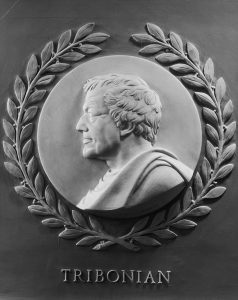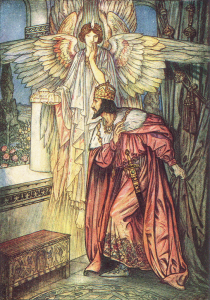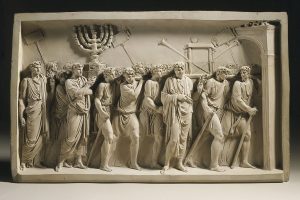
530 AD to 550 AD, Psalm 74: Hagia Sophia.
This site was first built in French (see www.147thgeneration.net). The English translation was mainly done using « google translation ». We have tried to correct the result of this translation to avoid interpretation errors. However, it is likely that there are unsatisfactory translations, do not hesitate to communicate them to us for correction.
(for that click on this paragraph)
Summary
This generation is from the years 530 AD to 550 AD.
According to our count, this generation is the 74th generation associated with Psalm 74. It is in this Psalm 74 that we therefore find an illustration of the facts of this generation.
During this generation, simultaneously, two great figures came to the reign of the two great powers of east and west of the time: Byzantium and Persia. Thus Justinian I in Byzantium and Khosrô I in Persia. These two monarchs, although called upon to clash on various occasions, consolidate their respective empires politically and economically.
A riot at the beginning of reign of Justinian wreaks havoc on Constantinople; in particular Hagia Sophia is burned and destroyed. His management of the crisis puts an end to the turbulence of the empire auguring a stable reign.
As a symbol of this reign, Hagia Sophia is rebuilt. The new churches and cathedrals must mark the supremacy of the new religion in relation to Judaism, they must therefore surpass the symbol of it, the Temple of Solomon. Justinian, entering the building for the first time, remains silent for a long time before muttering: « Solomon, I have surpassed you ».
While Christianity creates a box of choice to its emblems, those of Judaism pursue their odyssey in a certain indifference. In 534, in Constantinople, to celebrate the victory over the Vandals, a procession takes place with the war chest. This includes the Menorah which Titus seized in AD 71 at the Temple in Jerusalem in order to take it to Rome. Genséric had taken it there in 455 to take it to Carthage.
This generation 74 is special because it is both the middle generation of the second night watch (generations 50 to 98) and of all 3 night watches (generations 1 to 147).
During the first half of the night (generations 1 to 73/74), the Jewish kingdom was dislocated, the temple was destroyed twice, and the Jewish people sank into exile. At the same time, the ancient world collapsed, the Greek and Roman empires are now a thing of the past.
The second half of the night (generations 74/75 to 147) opens up to the new division of the world. On the one hand, the Christian West, which is setting up its organization, on the other hand, the East or Persia, which will soon serve as a breeding ground for Muslim expansion. This new world which is being born is far from promising for the Jews: whether it is by the new Christian laws or by the statute of dhimmi, the Jews will be confined to the statute of pariah.
Talk
Justinian I and Khosrô I
During this generation two great characters will simultaneously gain access to the reign of the two great powers of East and West, Byzantium and Persia.
Thus Justinian I (who reigned from 527 to 565) came to power in Byzantium and Khosrô I (who reigned from 531 to 579) came to power in Persia.
These two monarchs, although called to clash at various times, consolidate their respective empires politically and economically.
Khosrô I undertakes a great job of rebuilding the infrastructure of the empire, reorganizes the army and makes « taxation » more fair and more effective. The policy towards the Jews as towards the Christians marks a certain appeasement compared to the excesses of its predecessor.
Justinian [1] already had in 519, under the reign of Justin I, worked for the reunification of the churches of the old and the new Rome (Rome and Byzantium).

With the help of Tribonien (from 529), he worked on the redesign of Roman law. A riot at the beginning of his reign (532) wreaks havoc on Constantinople; in particular Hagia Sophia is burned and destroyed. The revolt is finally mired in the blood, Justinian also reform the « taxation », a source of revolt.
His management of the crisis puts an end to the turbulence of the empire auguring a stable reign for Justinian. As a symbol of this reign, Saint Sophia is rebuilt.
This inner stability allows Justinian to consolidate his empire:

- During[5] the period following the Nika sedition (the revolt mentioned above) and peace with the Persians eight months later, Justinian had the opportunity to take an interest in the reconquest of the Western Empire. Previously, such a reconquest would have been impossible: the empire was already struggling to protect itself from the Germanic and Slavic tribes who kept harassing it on its borders, while the growing number of barbarians in the army itself in made loyalty uncertain. But these problems were largely resolved.
With the help of Belisarius, Justinian reconquires in North Africa in 534 then in the hands of the Vandals. Then he takes care of Italy then controlled by the Goths which finally falls in 540 after the fall of Ravenna.
This victory is quickly tarnished, because at the same time, Khosro 1st breaking his agreement with Byzantium invades Syria, Antioch fell on the same date in 540. The looting of Antioch was probably enough for Khosrô who concludes a peace with Byzantium for payment an annual tribute. The end of this generation is marked by a weakening of the new Byzantine conquests in North Africa by a Moorish insurrection and in Italy by an attempt of reconquest by the Goths.
Beyond these aspects, the arrival of Justinian in power marks a turning point for the attitude of the Christian world towards the Jews, prefiguring tense relations that will prevail for long centuries on Christian soil:
- Between[4] Theodosius II and the advent of Justinian I, the Jews of Palestine were able to enjoy relative peace. […] Justinian wanted to revive the idea of the unity of empire and saw himself as the guardian of orthodoxy. To win the West, he had to fight the Monophysites, but he ran the risk of encouraging separatist tendencies in the Eastern Monophysite Churches (especially in Egypt and Syria). Caught in this dilemma, he turned towards an increasingly severe policy against these Monophysites, especially after the death of his wife Theodora (548), who was favorable to them. It is against this background that we must consider the legislation on the Jews, which experienced a revival of rigor under his reign. Justinian was innovative in starting from a broad conception of the notion of dissidents which no longer included only Christian « heretics » but all non-Orthodox groups, especially Jews (and Samaritans). This new position is found in a Novelle of 535 – which however only applies to Africa – in which Jews and heretics are prohibited from practicing their worship.
- Justinian’s legislation on Jews touches both civil law and religious matters. […]
- The year 533 saw the peak of this legislation (on Christian slaves of Jews): Jews must free their slaves even without compensation when they receive baptism. Like all legislation on slaves, this decree too is based on economic reasons. It amounts to preventing Jews from practicing crafts, since slaves can obtain freedom simply by joining Christianity. […]
- Justinian was the first to deny Jews the right to appear as witnesses against an (Orthodox) Christian in a court of law. […]
- Overall, Justinian took over the Jewish legislation from his predecessors and strengthened it. It is significant that the compilation of the constitutions which he ordered and which was promulgated in 534 (Justinian Code) does not repeat almost any of the laws of the Theodosian Code aimed at the protection of the synagogues, while Christian embezzlement had certainly not diminished. The fundamental novelty was the interference of the emperor in the internal affairs of the Jewish religion by the Novelle CXLVI (which legislates on what the Jews must believe: resurrection of the dead, existence of angels, last judgment…). The influence of the Justinian Code was of primary importance. The legislation on the Jews it contained was the starting point of all subsequent jurisprudence and remained in force well beyond the Middle Ages.
A middle generation
This generation, the seventy-fourth is in fact the twenty-fifth of the second cycle of the night which includes forty-nine, it is therefore the middle generation.
Similarly, if we consider the three cycles of forty-nine generations each, that is, the one hundred and forty-seven generations of the night, this generation is still the middle generation, since seventy-three generations have succeeded one another before this one and there are still seventy-three after it before the night ends.
This explains the beginning of this psalm where its author expresses his concern.
During the first half of the night, the Jewish kingdom was dislocated, the temple was destroyed twice and the Jewish people sunk into exile.
At the same time the ancient world collapsed, the Greek and Roman empires are now a thing of the past.
The second half of the night opens with the new division of the world, on the one hand the Christian West which sets up its organization through the new Byzantine Emperor, on the other the East where Persia consolidates its a grip that will soon serve as a breeding ground for Muslim expansion.
This new world that is born is far from promising for the Jews.
Justinian’s new laws endorse a status of pariah that will stick for many centuries to the Jews of the West until leading to the disasters of the twentieth century after a fallen hope of emancipation.
On the eastern side, Islam will quickly confine the Jews in a status of Dhimmi, which again will lock them into a status of pariah, even if it, a priori, engender fewer massacres in the West.
The patience of the Jews during this first part of the night will unfortunately still be necessary for the second part of the night.
It is this observation that Assaf expresses in the beginning of the psalm of this generation:

- A maskil of Asaph. Why, O God, have You forsaken forever? [Why] is Your wrath kindled against the flock of Your pasture?
- Remember Your congregation, which You acquired from time immemorial; You redeemed the tribe of Your heritage, Mount Zion on which You dwelt.
Assaf can conclude this first part by the ruin of the sanctuary, because if it was destroyed during the first part of the night, during the second part of the night, the nations will strive to try to demonstrate that the Jewish people is the people of God finally fallen, replaced by the Verus Israel, which will be either the Christian community in the West or the Muslim Ummah (community) in the East.
These two new religious communities that validate in particular the prophetic writings of the Old Testament retain from them only those who overwhelm the Jews but not those who predict the resurrection of the Jewish people.
Hagia Sophia reconstructed
Thus in this generation, the construction of the Saint Sophia church in Constantinople on the eastern and western frontier is symbolic of this attitude of disdain for the Jews that will last for centuries.
The new churches and cathedrals must mark the supremacy of the new religion in relation to Judaism, they must therefore surpass the symbol of it, the Temple of Solomon.
The case must be superior but also the treasures contained:
- The splendor [2] of the church (Saint Sophia) was not limited to its decoration: its architecture even seemed a miracle to its first visitors. For most of them, the most magical element was the extraordinary cupola, thirty-two meters in diameter, fifty-eight feet above the ground, larger and higher than all the others, a thin shell pierced with forty windows at its base so that it seems « suspended in the sky by a chain of gold ». Do not forget the furniture: the iconostasis of nearly twenty meters in sterling silver, the altar inlaid with gold and precious stones, the huge circular ambulatory for priests, illuminated by polychrome marble and mosaics, countless gold lamps. The relics were also more precious than those of all other churches, starting with the True Cross that had been brought back from Jerusalem, along with other instruments of the Passion, the Empress Helen. There were also swaddling clothes of Jesus and the table where the apostles had surrounded him for the Last Supper. It is hardly surprising that Justinian, entering the building for the first time on December 27, 537 – five years, ten months, and four days after laying the foundation stone – remained silent for a long time before whispering, » Solomon, I have surpassed you. «
The remains of the Temple

While Christianity creates a box of choice to its emblems, thoseCrédit images et vidéos associées au psaume 74. of Judaism pursue their odyssey in a certain indifference:
- The procession [3] [in 534, at Constantinople to celebrate the victory of Belisarius at Carthage on the Vandals] continued with a succession of wagons carrying the war chest. Including the Menorah, the seven-branched sacred candelabrum of which the Emperor Titus had seized in Jerusalem in the year 71 at the Temple of Jerusalem to carry it to Rome. Genseric had taken it in 455 to take it to Carthage. (Later on the request of representatives of the Jewish community, Justinian sent her back to Jerusalem with other liturgical objects of the Temple)
It is this substitution of emblems that the following verses of the Psalm evoke:

- Raise Your blows to inflict eternal ruin, for all the evil that the enemy did in the Sanctuary.
- Your adversaries roared in the midst of Your meeting place; they made their signs for signs.
- Based on these observations, the following of the psalm marks the impatience of Assas when the fate of the Jewish people who suffered the attack of the nations during the whole half of the night and which probably will have to continue to undergo them during the second part of the night:
- May he be known as though bringing [their blows] on high; the hatchets were in the thicket of the trees.
- And now, its entrances together, with hatchets and hammers they strike.
- They set Your Sanctuary afire; to the ground they profaned the dwelling place of Your name.
- They said in their heart, their rulers together; they burned all the meeting places of God in the land.
- We have not seen our signs; there is no longer a prophet, and no one with us knows how long.
- How long, O God, will the adversary blaspheme? Will the enemy disgrace Your name forever?
And Assas to remind God of his promises of the final redemption of the Jewish people, recalling the wonders of creation that the exactions of his creatures should not tarnish in the end of the psalm of this generation (not repeated here).

[1] According to:John Julius Norwich / History of Byzantium / Chapter: The Early Centuries (French: « Histoire de Byzance », Chapitre : les premiers siècles (p. 81 à 84) ).
[2] John Julius Norwich / History of Byzantium / Chapter: The Early Centuries (French: « Histoire de Byzance », Chapitre : les premiers siècles (p. 84 et 85) ).
[3] John Julius Norwich / History of Byzantium / Chapter: « The first centuries / The taking of Carthage » (French: « Histoire de Byzance », Chapitre : « Les premiers siècles/La prise de Carthage » (p. 87) ).
[4] Peter Schäfer / History of the Jews in Antiquity / Chapter: Justinian I (french reference : Peter Schäfer/Histoire des Juifs dans l’antiquité/Chapitre : Justinien 1er (p. 217 à 219) )
[5] John Julius Norwich / History of Byzantium / Chapter: the first centuries (French: « Histoire de Byzance », Chapitre : les premiers siècles (p. 85) ).




